Cataract Awareness Month
June is Cataract Awareness Month
Cataracts are the leading cause of blindness in the United States, according to Prevent Blindness America, which declared June as Cataract Awareness Month. Cataracts affect more than 24 million Americans 40 and older. More than half of all Americans have cataracts by the time they are 80 years old, but cataracts can also appear in young adults or even newborns. Prevent Blindness America (PBA) estimates that by 2020, 30 million Americans will have cataracts. Unlike many other causes of vision loss, vision loss resulting from cataracts can be managed or significantly restored. There is no better time than Cataract Awareness Month to learn the symptoms and risk factors of cataracts, and to schedule an appointment with your eye care professional.
What Causes Cataracts?
There are several risk factors that may lead to cataracts, including:
- Heredity–family history of cataracts
- Inflammation of the eye
- Certain diseases such as diabetes or metabolic disorders, which can increase your risk of developing cataracts
- Intense heat or long-term exposure to UV rays from the sun
- German measles while pregnant can cause the newborn to be born with cataracts
- Long-term steroid use
- Eye injury, also known as traumatic cataracts
- Hypertension
- Smoking or alcohol use
- High myopia, or nearsightedness
- Medications such as statin medicines used to reduce cholesterol, or hormone replacement therapy
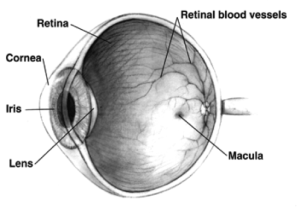
Cataracts may develop in one eye, particularly traumatic cataracts. More often, they develop in both lenses. Like myopia or astigmatism, they don’t always advance in the same way or at the same rate. One eye can have greater vision loss than the other as cataracts develop.
How does Cataracts Affect Vision?
The lens of the eye contains mostly water and protein. The protein in the eye is normally arranged in a way that keeps the lens clear, allowing light to pass through it. Cataracts occur when proteins in the lens of the eye begin to clump up.
The lens of the eye acts as a camera lens. It focuses light on the retina for clear vision. It also adjusts the eye’s focus, helping us to see things both close and far away.
There are several types of cataracts, and they are categorized by where they form and what causes them.
- A subcapsular cataract forms at the back of the lens. This type is more common in people with diabetes or those taking high doses of steroids. This form of cataract will interfere with reading and reduce your vision in bright light and can cause glare or halos around lights at night.
- A nuclear cataract forms in the nucleus (central zone) of the lens. These cataracts most often occur because of aging. This cataract will turn your lenses brown and interfere with your ability to detect color.
- A cortical cataract forms white, wedge-like opacities that start at the edge of the lens and work their way to the center. They look like wagon spokes and form in the lens cortex. This is the part of the lens that surrounds the central nucleus. These types of cataracts affect your peripheral vision and causes problems with glare.
Since cataracts tend to form over a long period of time, you may not know you have a cataract for years. If left undiagnosed, your vision may eventually acquire a brownish shade. Here, the cataract doesn’t affect your vision. As cataracts progresses, you may lose the ability to identify blues and purples. Your vision will start to dull or blur, and you will develop poor night vision, and halos may appear around lights, headlights, or lamplights. Having to change prescriptions in your eyeglasses or contacts regularly can also be a sign of a developing cataract.

How are Cataracts Detected?
A comprehensive eye exam includes testing for cataracts and other disorders of the eye such as macular degeneration and glaucoma.
You can expect:
- A review of your personal and family health history including any history of eye problems.
- A visual acuity test to determine how well you see at various distances.
- A dilated eye exam, where drops are placed in your eyes to dilate your pupils. Your retinas and optic nerves will be examined for signs of damage and other issues.
- Tonometry will measure the pressure inside the eyes. Numbing drops might be applied for this test.
If your doctor detects signs of a cataract, they might do additional testing to see whether your eyes are sensitive to light or if your peripheral vision (side vision) is affected.
If you are Diagnosed with Cataracts
There are several treatment options available for cataracts, depending on the severity. Your eye care professional will probably recommend new eyeglasses, brighter lighting, anti-glare sunglasses, or magnifying lenses. If these measures prove unsuccessful, the only option left is surgery. Some people can go years before needing surgery.
When the Treatment is Surgery
Traditional cataract surgery typically involves using a blade to remove the clouded lens and replacing it with an artificial one. It is usually only recommended when vision loss interferes with your daily activities, but it can also be recommended if it interferes with the eye care professional’s ability to examine or treat the rest of your eye. Laser cataract surgery provides a level of safety and comfort similar to bladeless LASIK where a femtosecond laser is used to make to make the incision.
Cataract surgery can slightly increase your risk of retinal detachment especially if you have other eye conditions which can also increase your risk. Talk with your eye care professional about the pros and cons of any options you are considering.
That said, cataract surgery is one of the most commonly performed surgeries, and is usually an outpatient procedure. More than 3 million Americans undergo cataract surgery every year, according to PBA. Nearly nine out of ten people who have cataract surgery regain very good vision, between 20/20 and 20/40.
It is important to speak with your doctor about vision issues you might be having, and to make informed decisions about the care and protection of your eyes. Your eye care professional should be able to sit down with you and discuss all your risk factors and help you weigh those against the benefits of the treatment options offered. If you are 65 or older, it’s important to get a complete eye exam every one or two years, even if you have no problems seeing. Schedule your appointment during Cataract Awareness Month and be proactive about your eye health.
6 Tips to Maintain Healthy Vision
6 Tips You Can Do Right Now to Maintain Healthy Vision
#1 – Wear Sunglasses
You probably know the sun can damage your skin… but did you realize the risk the sun poses on the health of your eyes? While sunglasses are a great aesthetic accessory, protection from UV Rays is ultimately what they’re used for.
Be careful to avoid these harmful side effects from the sun:
- Cataracts, which is when the lens of the eyes becomes cloudy, resulting in blurred vision. Approximately 20% of all cases are a result of UV exposure.
- Macular Degeneration happens when the retina is damaged and destroys central vision. This is the leading cause of blindness.
- Pterygium is a growth of tissue on the white part of the surface of your eye that affects the curve of your eyeball. The result is astigmatism.
When purchasing sunglasses look for something that blocks almost 100% of UVB and UVA radiation.
#2 – Quit Smoking
Did you know smoking can be harmful to your eyes? Sight -related problems are rarely discussed, so here are a few reasons that might help you kick the habit:
- Studies show that smokers are at three times the risk for developing AMD, and female smokers aged 80 plus are over 5.5 times likely to acquire AMD than those that don’t smoke and are the same age.
- Smoking doubles the risk of diabetes. Smoking is also a risk factor for progression of diabetic retinopathy, and hypertension.
- Smokers show higher rates of blindness and other issues in old age.
#3 – Annual Eye Exams Are Necessary
Recent studies have found that 25% of adults have not had their eyes checked in the last two years. Studies also show that 25% of all people are unaware that a simple eye exam can prevent blindness. If you’ve had laser vision surgery or are naturally blessed with good vision, it is still recommended that you have regular eye exams, preferably annually (after age 40).
“Vision tests” are not the same as having a complete eye exam. A thorough eye exam performed by an optometrist or ophthalmologist can detect potentially harmful diseases, vision disorders, and issues with the muscles in your eyes. If things begin to look blurry or you have trouble seeing objects far or near, this is an indication that you should have your eyes checked.
 #4 – Healthy Eating for Healthy Vision
#4 – Healthy Eating for Healthy Vision
There is a strong connection between food and one’s overall health. It has become apparent that having a healthy diet rich in vitamins and minerals provides long-term protection for your vision. Physicians tell us, “One of the best things you can do for your eyes is to eat a balanced diet high in fruits and vegetables, but also low in saturated fats and sugar.
#6 – Ensure the health of your Eyes by Washing Your Hands
The number of times you wash your hands daily can prevent the spread of infectious diseases, according to the Centers for Disease Control. By washing your hands frequently, you prevent the collection of dirt and germs that may be easily transferred to the eyes. This is caused by we touch this area subconsciously throughout the day. Not only will it reduce the chances of getting sick, it also helps control the spread of bacteria and viruses that are responsible for causing as-conjunctivitis (pinkeye) as well as corneal ulcers.
A great habit to practice is washing your hands before you eat or prepare food, before you treat injuries, before using any type of dispensing machine, and before you take out or put in contact lenses. An important instance where washing your hands should be your number one priority is before you get something in your eye or eyelash.
Some quick facts to digest when it comes to the protection of your eyes via washing your hands:
- Half of all people fail to wash their hands after sneezing or coughing.
- Over half of all men and almost one fourth of women doesn’t wash their hands after using restroom facilities.
- Over one third of all people don’t think it is necessary to wash their hands before a meal.
- Left-handed people tend to wash their right hand more thoroughly than they’re left and conversely for right handed people.
We hope these tips help you in your quest for top-notch vision! For more information please visit our Homepage.
Cataract Newsletter
Cataract Surgery Risks and Benefits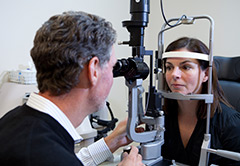
Cataract surgery has changed over the past 20 years from large incisions with long recovery times to our current surgery with a 2.4mm incision, self sealing wound, and possible expectations of refractive benefits where glasses are not required for distance nor near. Some of the greatest difficulties with cataract surgery involve managing reasonable expectations.
This letter will review cataract surgery and its risks and benefits. It will focus on the new refractive options that are available because of new lens designs. Lastly, it will review unexpected benefits about glaucoma.
Cataract surgery involves the removal of a cloudy lens from the center of the eye and its replacement with a thin plastic lens that is designed to focus the light on the retina. The normal lens is optically clear but as we age, and occasionally in association trauma or illness, the lens becomes cloudy and discolored. It is no longer able to focus the light but rather causes the light to amplify or scatter in a random manner, what you might describe as glare or blurred vision. If these changes interfere with your daily activities and quality of life, it is reasonable to consider surgery. Your doctor will also consider other factors, beyond the scope of this letter, when considering your cataract.
While cataract surgery is one of the most successful and predictable surgeries, risks are still present. To each patient it remains a major surgery as there is the potential for vision loss and rarely actual loss of the eye from infection, bleeding or retinal detachment.
The excitement of cataract surgery comes from the refinements in instruments that allow a very small self sealing wound and the precise calculation of a monofocal lens implant that minimizes the need for glasses after surgery. Often, the residual refractive error, or need for glasses, is not significant and the patient is content with only reading glasses.
The special lens is also available to treat most astigmatism. These toric lenses are aligned with your eye to treat the moderate corneal irregular curvature that is not treated by a standard lens. The higher level of premium lens implant is a multifocal lens that is designed to minimize the need for distance and near vision glasses. There are multiple brands that utilize different technologies, but the goal is to have some light focused for near and some for far. This may limit contrast sensitivity and can be associated with a glare but for many patients, the benefits far exceed these issues. Not every patient is a candidate for the toric or the multifocal implant and for that reason, Medicare allows an out of pocket charge for the extra evaluation and services. Patients with dry eyes or other surface abnormalities do not tolerate these lenses well, and some consider macular degeneration to be a relative contraindication. Your doctor will take these factors into consideration if you are considering a premium lens implant.
Recent studies have highlighted other benefits of cataract surgery.
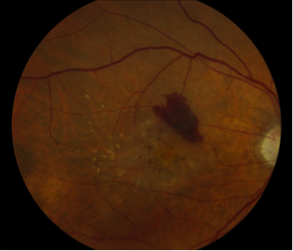 The Ocular Hypertension Treatment Study reported on the benefits of cataract surgery in patients with ocular hypertension in September 2012. The report had a better design and confirmed what other studies had reported, a reduction in postoperative intraocular pressure. There was an average 16.5% reduction in IOP and there was a greater reduction in eyes with the highest preoperative pressure. A lower intraocular pressure limits the potential for glaucoma damage and in some patients may make glaucoma drop therapy no longer necessary. This can be a considerable financial saving given the price of glaucoma medications.
The Ocular Hypertension Treatment Study reported on the benefits of cataract surgery in patients with ocular hypertension in September 2012. The report had a better design and confirmed what other studies had reported, a reduction in postoperative intraocular pressure. There was an average 16.5% reduction in IOP and there was a greater reduction in eyes with the highest preoperative pressure. A lower intraocular pressure limits the potential for glaucoma damage and in some patients may make glaucoma drop therapy no longer necessary. This can be a considerable financial saving given the price of glaucoma medications.
In July 2012, a new study published in The Journal of the American Medical Association examined the incidence of hip fractures in the year after cataract surgery. The study showed 16% fewer hip fractures in the year after surgery. Interestingly, the patients between the ages of 65 and 69 had a slightly higher rate of hip fracture but the patients ages 80 to 84 experienced a 28% reduction in hip fractures compared to those Medicare beneficiaries who did not have cataract surgery.
Other studies have shown benefits in mental health and overall quality of life after cataract surgery. It is a very exciting time in ophthalmology and cataract care. It is amazing to think of the distance we have covered in the last 20 years. While all surgeries carry some risk, there is a lot more to be excited about than feared when you are told, “ You have cataracts and we need to consider surgery to make you see better.”
For more information please visit our Home Page.
Flashers, Floaters and Retinal Detachment
What are flashers and floaters? What causes them?
The center of the eye is filled with a clear gel called vitreous. When we are born, the vitreous in both eyes is completely clear and stuck down everywhere to the inside surface of the eye (including the retina). As we get older the gel clumps together, these cast shadows on the retina (light sending part of the eye) causing the occasional floaters we see.
After several decades (usually after age 50) the gel liquefies and starts to separate from the back of the eye. This is called posterior vitreous separation, or detachment. When this occurs a larger floater can be seen. People sometimes describe this as a circle, a cobweb, a spider, etc. (Figure 1).
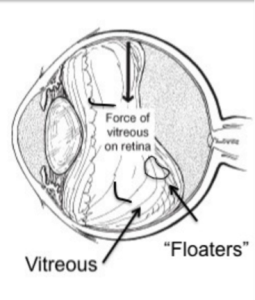 As the separation progresses (usually over 4-6 weeks) the gel can tug on the retina (back of the eye). This causes flashes of lights. Though the flashes do not cause damage, a flash could indicated that the gel is pulling especially hard increasing risk of a tear in the retina.
As the separation progresses (usually over 4-6 weeks) the gel can tug on the retina (back of the eye). This causes flashes of lights. Though the flashes do not cause damage, a flash could indicated that the gel is pulling especially hard increasing risk of a tear in the retina.
The appearance of flashes and floaters may be alarming, especially if they develop suddenly. You should contact your eye doctor right away if you suddenly develop new flashes or floaters.
Are floaters ever serious?
The retina can tear if the shrinking vitreous gel pulls away from the wall of the eye. This sometimes causes a small amount of bleeding in the eye that may appear as new floaters. A torn retina (Figure 2) is always a problem, since it can lead to a retinal detachment. You should call your eye doctor as soon as possible if:
- Even one new floater appears suddenly
- Lots of “pepper spots” in your vision
- You see sudden flashes of light
- You notice loss of any peripheral (side) vision
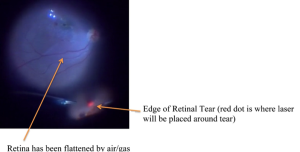
How are your eyes examined for flashes and/or floaters?
When an ophthalmologist examines your eyes, your pupils will be dilated with eye drops. During this examination, your ophthalmologist will carefully observe your retina and vitreous using a bright light. Evaluation for retinal tears usually requires a technique called scleral depression, for which your ophthalmologist will use an instrument to gently press on your eyelids. This office examination is done with minimal discomfort. Because your eyes have been dilated, you may need to make arrangements for someone to drive you home afterwards.
Floaters and flashes of light become more common as we grow older. While not all floaters and flashes are serious, you should always have a medical eye examination by an ophthalmologist to make sure there has been no damage to your retina.
What can be done about floaters?
Floaters can get in the way of clear vision, which may be quite annoying, especially if you are trying to read. Though most floaters will always be there, people usually notice less over time. Floaters can be surgically removed (with surgery called vitrectomy – Figure 3), but this is not performed routinely as most people have minimal symptoms after a couple of months. Even if you have had some floaters for years, you should have an eye examination immediately if you notice new ones.
What is retinal detachment?
The retina is the sensory tissue that lines the back wall of the eye. It can be described as the wallpaper of the back of your eye. A retinal detachment occurs when the retina is separated from the inside of your eye and can no longer transmit images properly through the optic nerve to the brain. The center of the retina is the macula. If the macula is involved in the detachment, the vision is often extremely blurred. If the macula is not involved in the area of detachment, there may be some loss of peripheral vision.
Is a retinal detachment serious?
Yes. A retinal detachment is a very serious problem that will almost always lead to blindness if not treated.
What causes retinal detachment?
As described above, in some cases vitreous separation can cause a tear (or tears) in the retina. As time passes, fluid from the center of the eye will pass through the tear and begin accumulating beneath the retina, causing a retinal detachment. There are some conditions that increase the likelihood of developing a retinal detachment. These include:
- Myopia (nearsightedness)
- Traumatic Injury
- A history of retinal detachment in either eye
- Family history of retinal detachment
What are the symptoms of retinal detachment?
- A new floater or several floaters can be hundreds) that appear suddenly
- Sudden flashes of light in the eye
- Seeing “cobwebs” or hairs in the field of vision
- Impression of a curtain or veil coming down over vision (loss of peripheral, and then central, vision)
- Blurred vision
- Pain is not a symptom of a detached retina
How is retinal detachment repaired?
A retinal detachment can be repaired in several different ways. The surgery chosen depends on the age of the patient, the type of retinal detachment, whether the patient has had cataract surgery or not, surgeon preference, and other factors. The four general categories of retinal detachment are:
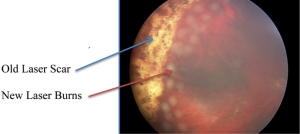
Figure 5
- Laser barricade (Figure 5) – does not fix the detachment but prevents it from spreading; can be done in the office).
- Pneumatic Retinopexy – a combination of treating the tear with cryotherapy (freezing treatment) or laser and the use of a gas bubble injected into the eye to help the eye get rid of the fluid. Figure 6 shows the injection of a gas bubble that will cover the tear in the retina. This prevents fluid from getting behind the retina and allows the body to absorb the fluid and flatten the retina.
- Scleral Buckle – a scleral buckle involves first treating the tear in the retina with cryotherapy (freezing treatment) and then placing a silicone band under the muscles around the eye to support the tear. The fluids can be drained from under the retina or a gas bubble can be injected into the eye similar to pneumatic retinopexy.
- Vitrectomy – vitrectomy involves the removal of the vitreous (floaters) from the eye using small instruments (Figure 3). This removes all the traction (pulling) on the retinal tear(s) and detachment. The vitreous space is then filled with a long-lasting gas bubble that keeps the retina flat until the tears heal. Laser is then used to seal the tear(s) (Figure 8).

Figure 8
Sometimes both a scleral buckle procedure and a vitrectomy are used together to fix complex retinal detachments.
All diagrams from Ryan SJ, Retina. 4th ed. www.retinatext.com, Elsevier; 2006
See Your Eye Doctor Every Year
Why you should see an eye doctor annually
Your vision is a critical part of your overall health. When going in your regular annual physical checkup, it is important to also make sure that you have your vision checked as well. During an eye exam, your physician will check for signs of glaucoma, age-related macular degeneration, cataracts and diabetic retinopathy, among other diseases. So what is part of a traditional eye exam?
Eye Exam
The doctor will perform these typical eye tests as part of your annual exam. The first is the eye muscle movement test, which is meant to make sure that your eyes are aligning normally. Part of the test includes having your doctor ask you to track targets in various directions, then they will observe how your eye moves and note any areas of potential concern. If there are areas of concern, your doctor will prescribe treatments to deal with those concerns.
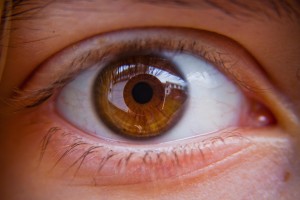 Cover Test
Cover Test
The cover test is a check of how well your eyes are working in concert with each other. As you stare at a designated target in the distance, the doctor will cover and uncover your eyes one at a time. This will allow them to observe the movements of your eyes, watching to see if one of the eyes turns away from the target. This test can be repeated with the target close by as well.
External Test
During the external exam and pupillary reactions will test your pupils ‘reactions to both light and other objects at close distances. The doctor will also examine the exterior of the eye, looking for any changes in the condition of the white area of the eye and the overall position of the eyelids. If you continue to have a regular annual exam, then your doctor can track any changes over time and address them right away.
Visual Acuity Test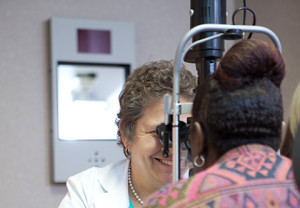
The visual acuity test requires you to sit in front of an eye chart, with letters that get gradually smaller as you read down the lines. You may be required to cover one eye or the other as part of this test. Depending on how good your vision is, you may be able to read the whole chart or be stuck part way down.
If you have difficulties with this chart, then you may be required to get a prescription for glasses or contacts to correct your vision issues. This will mean that you need to have a refraction test to determine your exact lens prescription. Additionally, you may need to have a glaucoma test to check the fluid pressure in your eyes falls within the normal range. The test is painless and usually takes just a few minutes to perform.
There are a few other tests that are included in a typical eye exam, but all these check the health of your eyes and their various parts. These tests are all geared to locating any potential issues with your eyes, but also how they can be indicative of other diseases or potential issues within your body as a whole. Be sure to have your eyes checked annually as part of an overall healthy lifestyle.
Macular Hole FAQs
What is Macular Hole?
A macular hole is a small full-thickness defect in macula, the most important region of your retina. The macula is the center of the retina, which is the light sensing part of the back of the eye. Formation of the hole causes loss of central vision (reading, driving, recognizing faces is affected).
What types of symptoms do patients with Macular Hole have?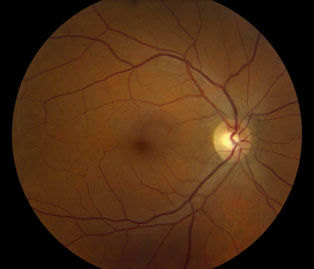
Symptoms vary based on the size of the hole. The most typical symptoms are:
- Distortion of vision (called metamorphopsia) – letters look crooked
- Blurred vision or loss of visual acuity
- Dark spot at center of vision (central scotoma) – patients describe missing letters in words when looking right at the word. These dark spots are different than floaters as they do not move around.
- Patient often first notices the vision loss when they cover up the unaffected/good eye.
What causes a Macular Hole?
The most common cause of a macular hole is a posterior vitreous degeneration. This is when the vitreous gel that fills the center of the eye liquefies and separates from the back surface of the inside of the eye (the retina). This results in traction/pulling in the central macula. If there is enough traction a hole forms.
Direct ocular trauma by a blunt force, like a tennis ball, can cause macular holes to form as well. This group of patients is more likely to have spontaneous closure without surgery.
Who is at risk?
Most patients that develop macular problems are in their 60s or 70s and women are more commonly affected. Most people will experience vitreous degeneration, but macular hole is not very common. It is not associated with any systemic disease.
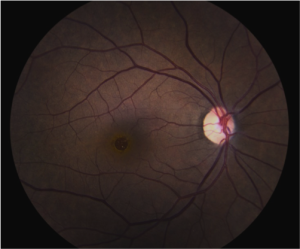 How are they diagnosed?
How are they diagnosed?
The macula can be visualized during a routine eye exam after dilation of the pupil. Optical coherence tomography is a type of non-invasive imaging that allows your physician to view the macula and macular hole (if present) in cross-section. This allows your physician to measure the exact size of the hole and study the anatomy. This is useful for knowing the likelihood of closure with surgery.
How are they treated?
Small holes will often spontaneously close/heal without treatment. In some cases medication (Jetrea) can be injected into the eye that will release traction on the hole and allow it to close, however there are a very few eyes that are candidates for this medication. Most macular holes are treated with surgery.
Surgery consists of vitrectomy to remove the vitreous gel (floaters) from the middle of the eye (Figure 6). Micro-forceps are then used to gently peel the membrane from the retinal surface from around the hole (Figure 7).
What is the vision like after surgery?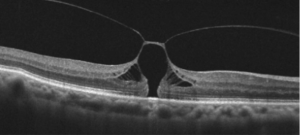
The vision is poor the day after surgery due to the gas bubble. Vision through gas is distorted and will remain so until the bubble resolves. There are usually position requirements after surgery to ensure the bubble is correctly positioned against the hole (each surgeon has their own post-operative position requirements based on their specific surgical technique). Historically, the patient was required to position face down for 14 days but currently close to 100% anatomical success can be achieved without face down positioning. The only requirement is that the patient not sleep on his/her back but to favor the opposite cheek being on the pillow.
Vision will improve after the gas bubble dissolves (this takes several weeks and timing depends on the type of gas used). Visual improvement can continue to occur for 9-12 months after successful surgery. If it has not already been removed, the cataract (cloudy lens of the eye) will worsen with this type of surgery, and this will cause worsening vision. Many times a combined approach is used and the cataract is removed at the same time as surgery for the macular hole.
Healing and approximation of the edges of the hole is out of the control of the surgeon. If the hole was small, the margins may come back perfectly and the vision returns to near normal. However, the tissues may not meet perfectly and there can be some residual distortion and blurred vision even if the hole is closed. There can be a persisting central dead spot in the vision if the central defect is filled in with scar tissue and the edges did not meet. This is most common in longstanding holes and larger holes.
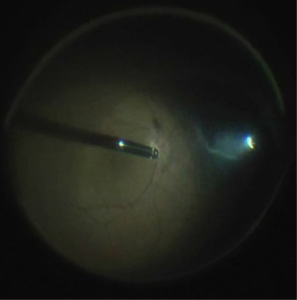 What are the restrictions after surgery? What are the risks of surgery?
What are the restrictions after surgery? What are the risks of surgery?
Restrictions in the postoperative period are most commonly related to the gas and the secondary poor vision. You cannot fly or travel to the mountains with an eye filled with gas. Patients should not drive or participate in activities that require depth perception and may result in injury.
Any intraocular surgery involving vitrectomy has a low risk of infection, bleeding, retinal detachment, and other complications, which can all lead to permanent vision loss. Risks, benefits, and alternatives to surgery should be discussed with your eye surgeon prior to proceeding with vitrectomy for macular hole.
Patient Portal
Patient Portal – Fast, Easy and Secure Communication
The Patient Portal is a website through which you may communicate with our office. Registered patients would have secured and confidential access to the website and may:
- Ask a question
- Receive a clinical summary of your office visit
- Receive results, education material and information online
- Request an appointment
- Request a medication refill
Why are we using the Patient Portal?
Implementing a patient portal bridges the gap between you and your provider and provides more efficient communication.
Sign Me Up!
To create an account in the Patient Portal, call us at 912-354-4800 or visit us and our expert staff can help you. We will create a NextMD account for you and give you a personal enrollment token (an 8-digit number used to sign in). Once we create your account, you will receive an email with instructions on how to enroll in the Patient Portal.
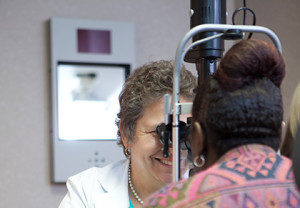 It’s Fast!
It’s Fast!
The Patient Portal provides instant, direct access to our providers and staff, providing a more streamlined health care experience. You can send and receive messages to staff and providers regarding your health care needs. You can request to renew medications online which will speed up the prescription process. Patient education, diagnostic testing results and a clinical summary of your visit will be sent to you so you can get on with your day.
It’s Easy!
The Patient Portal will allow you to request and manage your appointments at your convenience, from the comfort of your home or office. You can submit a request for an appointment or a medication refill 24 hours a day, 7 days a week. Once submitted, requests will generally be handled within 1-2 business days, excluding holidays, and weekends. If you have a non-urgent question, you can send us a message through the Patient Portal and we will answer the question as soon as possible. No more holding on the phone lines or waiting for a phone call back!
It’s Safe!
Our patients’ privacy is our number one concern. The Patient Portal is HIPAA compliant and gives secure access to each user so you can feel safe when using it. Each patient creates their own unique password and is asked a security question each time they login for maximum safety. No medical or personal information will be sent to you through your personal e-mail account.
Call us today at 912-354-4800 or visit us and our expert staff can help you!
Are e-readers bad for your eyes?
Are e-readers bad for your eyes?
Cataract Surgery Risks and Benefits
Cataract Operation Risks and Benefits
This letter will review cataract surgery and its risks and benefits. It will focus on the new refractive options that are available because of new len’s designs. Lastly, it will review unexpected benefits with respect to glaucoma.
While cataract surgery in is one of the most successful and predictable eye surgeries in Savannah, risks are still present. To each patient it remains a major surgery as there is the potential for vision loss and rarely actual loss of the eye from infection, bleeding or retinal detachment.
The excitement of cataracts operations come from the refinements in instruments that allow a very small self sealing wound and the precise calculation of a monofocal lens implant that minimizes the need for glasses after surgery. In many cases, the residual refractive error, or need for glasses, is not significant and the patient is content with only reading glasses.
The special lenses are also available to treat most astigmatism. These toric lenses are aligned with your eye to treat the moderate corneal irregular curvature that is not treated by a standard lens. The higher level of premium lens implant is a multifocal lens that is designed to minimize the need for distance and near vision glass. There are multiple brands that utilize different technologies, but the goal is to have some light focused for near and some for far.
This may limit contrast sensitivity and can be associated with glare but for many patients, the benefits far exceed these issues. Not every patient is a candidate for the toric or the multifocal implant and for that reason; Medicare allows an out of pocket charge for the extra evaluation and services. Patients with dry eyes or other surface abnormalities do not tolerate these lenses well, and some consider macular degeneration to be a relative contraindication. Your doctor will take these factors into consideration if you are considering a premium lens implant.
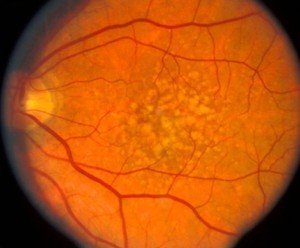 Recent studies have highlighted other benefits of cataract surgery
Recent studies have highlighted other benefits of cataract surgery
The Ocular Hypertension Treatment Study reported on the benefits of cataract operation in patients with ocular hypertension in September 2012. The report had a better design and confirmed what other studies had reported, a reduction in postoperative intraocular pressure. There was an average 16.5% reduction in IOP and there was a greater reduction in eyes with the highest preoperative pressure. A lower intraocular pressure limits the potential for glaucoma damage and in some patients may make glaucoma drop therapy no longer necessary. This can be a considerable financial saving given the price of glaucoma medications.
In July 2012, a new study published in The Journal of the American Medical Association examined the incidence of hip fractures in the year after a cataract procedure. The study showed a 16% fewer hip fractures in the year after surgery. Interestingly, the patients between the ages of 65 and 69 had a slightly higher rate of hip fracture but the patients ages 80 to 84 experienced a 28% reduction in hip fractures compared to those Medicare beneficiaries who did not have cataract surgery.
Other studies have shown benefits in mental health and overall quality of life after cataract surgery. It is a very exciting time in ophthalmology and cataracts care. It is amazing to think of the distance we have covered in the last 20 years. While all surgeries carry some risk, there is a lot more to be excited about than feared when you are told, “ You have cataracts and we need to consider a procedure to make you see better.”
Macular Degeneration, Aspirin and Cataract Surgery
 Macular Degeneration Relationship to Daily Aspirin and Cataract Surgery
Macular Degeneration Relationship to Daily Aspirin and Cataract Surgery
Age related Macular degeneration (AMD) is a leading cause of vision loss. It is a major health issue as our population ages and is eager to maintain independence. Preserving central vision allows us to drive and read our mail. Macular degeneration is referred to as dry or wet based on your physicians clinical findings.
Dry macular degeneration is characterized by a progressive thinning and atrophy of the macular region that results in poor central vision. Patients often describe a slow decline of vision with complaints of worsening contrast vision and the need for better lighting. You can think of it as “thread bare “ areas near the central vision that slowly expand leading to larger zones where there is no retina to receive the focused image. This only involves the central retina, or macula, and patients maintain peripheral vision. There is no bleeding or leakage of fluid into the retina.
Wet Age-Related Macular Degeneration
Wet age related macular degeneration, however, does involve bleeding and leakage of fluid into the central retina. This may occur relatively sudden and seemingly without warning. Common symptoms can include: sudden distortion of images or straight lines, a central gray or dark area, or just blurred vision. Early symptoms can be missed as we rarely check each eye individually and one eye may have problems while the other eye allows normal function. The bleeding and leakage of fluid associated with wet macular degeneration is the result of abnormal new vessels growing in the macular region. These new vessels tend to be fragile and may break and bleed without any action on your part.
As we age and become at risk for vascular events, prophylactic aspirin (ASA) has almost become a standard of care. This attempt to prevent clotting and its associated morbidities are obviously at odds with the goals of our wet macular degeneration patients. Many studies have looked at the association between ASA and wet AMDwith respect to causation and prognosis. It is a complex question as vascular disease is more common in patients with macular degeneration and smoking is an independent risk factor for both conditions.
In January 2012 The European Eye (EUREYE) Study reported on the association of ASA and AMD, as determined by questionnaire, within a group of 4700 patients. There was a variable use of ASA and of AMD severity among the participants and they showed that “frequent aspirin use was associated with early and wet late AMD” and the odds were greater with increasing frequency of ASA use. This cross sectional study did not determine causation but only says there may be a link. Obviously, each patients use of ASA or any other supplement must be evaluated on an individual basis but a practical assessment would be that prevention of stroke or heart attack with ASA use will outweigh any concern of ASA causing macular degeneration. The benefit of a healthy diet in green leafy vegetables and smoking cessation far outweigh any concerns associated with aspirin use.
For those patients with newly diagnosed wet AMD and active bleeding, it is reasonable to discuss a change in anticoagulant therapy for the short term. Drugs like Plavix, Coumadin, Pradaxa, and aspirin can exacerbate the bleeding with wet AMD in the short term. Fortunately, the new injection therapies cause regression of the offending new vessels and thereby dramatically reduce the risk of bleeding after a few injections.
Cataract Operation
Another common association and concern is whether a cataract eye operations cause macular degeneration to advance. There are over 3,000,000 cataract surgeries performed each year in the U.S. and many studies have explored this relationship. In November 2009, The Age-Related Eye Disease Study Report No. 27 reviewed 1939 eyes that had cataract surgery while enrolled in the national trial that evaluated antioxidants and minerals in macular degeneration. Each group showed a gain in vision but there was a declining benefit with more advanced pre-existing AMD. The benefit ranged from a gain of more than 8 letters in the group without AMD to only 2 letters gained in the advance AMD group.
In November 2012 the Australian Cataract Surgery and Age-related Macular Degeneration (CSAMD) study reported on the possible association between cataract surgery and the progression of AMD. This study used a fellow eye comparison so that it only included patients who had cataract surgery in one eye and left the other cataract alone for two years. Cataract operations were performed in 1851 patients and 71% had 36 months of follow up. The study showed no increased risk of early AMD or late AMD. There was a slight increase in retinal pigmentary changes in the operated group but the significance is yet to be determined.
Conclusion
Macular degeneration is a complex disease with many contributing factors including genetics, diet, smoking, and exercise patterns. Each study sheds a little more light on the subject but often leaves us with more questions. We believe it is safe to conclude the following:
- A diet that contains green leafy vegetables and fresh fruits is recommended. Vitamin supplementation with an AREDS approved vitamin is advised for patients with intermediate or advanced macular degeneration in one eye.
- It is reasonable to use aspirin on a daily basis but the patient’s eye care specialist should be aware of use of any anticoagulants for other medical conditions.
- Cataract surgery is safe in patients with macular degeneration but it is reasonable to evaluate with a retinal scan or have a retinal consultation before surgery if there is any doubt about the role of AMD in a patient’s vision loss.
- Tobacco cessation is necessary and cessation counseling should be provided.

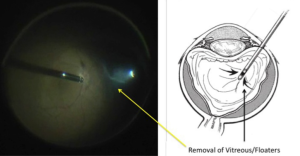
 She says that eye stress is all too common, in the form of…
She says that eye stress is all too common, in the form of…